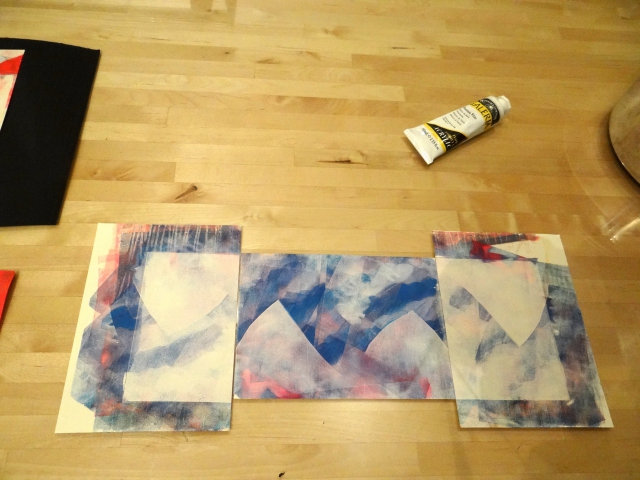
The way elements in successive prints reappear and evolve offers nice opportunities for multiple prints to be combined.

Rae Trujillo, an experienced gell printer, tries out the Gelli Plate while describing her own habit of using Knox Gellatin for her plates. Knox is much less expensive than the commercial product and a bit more fragile. But Rae says she can keep a gellatin plate in use for about a month of printing. Impressive.
To get this long life she says she refrigerates the plate when not in use. And when it starts to crack, she microwaves it to refresh it.
She says she doubles the quantity of gellatin to make a plate and refrigerates it to set it. I'm interested in whether a high concentration mix would gel at room temperature.

Judith Hoffman brought over her gell printing plate. She demonstrated the basics of gellatin printing to BA members at our Feb 2013 meeting. Here she's explaining the properties of the open acrylics she brought to print with.

I'm sure some cleaner effects could be achieved. Grungy textures are very easy to achieve.
The two prints at the bottom left were built up through many steps. There seems to be a lot of room to assemble a composition. For those prints I also pulled some white acrylic out. It wasn't the same 'open' formula so I mixed it with wheat paste to extend the working time. That made the texture a bit different than the other acrylics and brought in some transparency.
I wonder how watercolors would work in this process.
The morning after our meeting I tried straight acrylics on the glass top of one of my cabinets. Dried too fast, very strong adhesion to the glass. As a result, it tore the surface of the paper as I pulled the print. Members familiar with various printing techniques report that printing from plex or glass requires damping the paper first. I wonder if this is to facilitate transfer of the pigment to the sheet, compensating for the strong adhesion of pigment to printing substrate.
I could easily spend the day doing substrate and material tests but I've got binding projects to work on.